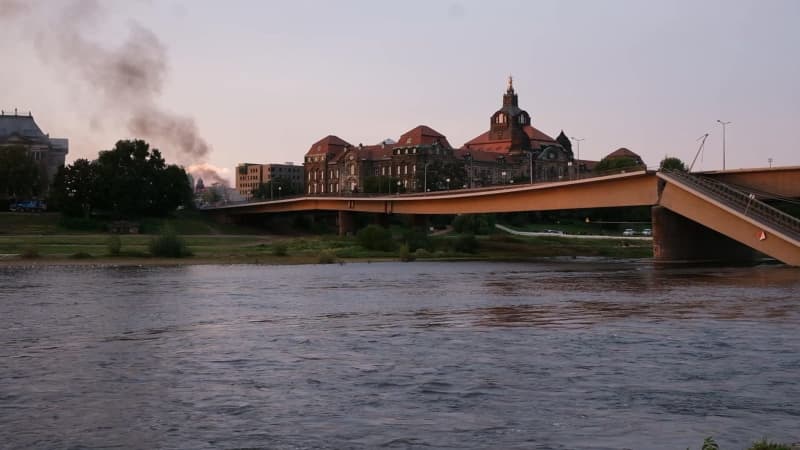Engineers in the German city of Dresden are working on Thursday evening to demolish the damaged section of a key bridge to prevent further danger and prevent flooding, a day after part of the bridge collapsed into the river.
According to fire department spokesman Michael Klahre, excavators and demolition vehicles from a specialist company are in operation. They are preparing for the partial demolition of bridge section C, which collapsed into the river in a night-time accident.
“The first priority is the sinking area,” Klahre said, noting that laser technology showed that remnants of that section of the bridge were slowly sinking. “We’re trying to stop the collapse,” he said.
Previously, tram tracks and district heating pipes were separated from each other with small explosions, after a 100-metre safety zone had been established.
Since the area includes the Ministry of Finance and some departments of the State Chancellery, the ministry and the relevant departments of the State Chancellery were the first to be evacuated.
Emergency services are running out of time as flooding is forecast to significantly increase the danger.
About 100 metres of the bridge collapsed into the Elbe in an accident that, if it had happened at a busier time, could have caused a disaster, as the bridge is on a major tram, cycle and pedestrian route.
Engineers are lowering the sagging section of the concrete bridge and the cantilever arm connected to the bank with the help of the German armed forces, the Federal Office for Technical Assistance (THW) and suitable technology. It is to be dismantled and taken away, an official said earlier.
Officials in Dresden are working as quickly as possible as the Elbe River is expected to overflow on Sunday due to heavy rainfall expected in neighbouring Czech Republic.
Heavy rain showers are forecast, with the National Flood Centre expecting around 200 millilitres of rain to fall in the Czech Republic and southern Poland within 72 hours by Monday.
In the higher mountain areas this can increase to 350 milliliters.
The German state of Saxony, where Dresden is located, is also preparing for persistent rainfall in the east. Flood warnings have also been issued for nearby rivers such as the Spree and the Lausitzer Neiße.
According to René Herold, head of the city council’s environmental department, minor flooding may occur next week due to expected rainfall in the Czech Republic.
According to forecasts, the water level in Dresden will rise between 5 and 8 meters by the middle of next week. Dams on the Czech side of the border will be lowered slightly as a precaution.
Officials in the Czech Republic said Wednesday that they do not plan to reduce the flow of the Elbe. “I am sure that our Saxon colleagues also understand that a bridge that has actually collapsed cannot now take priority over the protection of property and lives of not only Czech citizens, but also German citizens in particular,” Czech Agriculture Minister Marek Vyborny said.
The day after the partial collapse, the first safety work on the structure was carried out, with substructures being erected to support the bridgeheads.
Engineers also installed a tachometer on the bridge, a laser technology that can measure changes in the range of a tenth of a millimeter, the city said. Reference points were also installed around the bridge that indicated slight subsidence.
According to the fire department, the entire structure of the bridge has collapsed. The structure is approximately 400 meters long and consists of three parts that are connected to each other with cross beams.
The collapse occurred around 3 a.m. (01 a.m. GMT) on Wednesday morning after two sections of the bridge had recently been repaired.
The city noted how fortunate it was that the last tram that crossed the bridge about 10 minutes earlier was not on the structure at the time of the accident and that no one was injured.
Engineers are investigating the cause of the collapse, but police do not believe there was an external cause.

